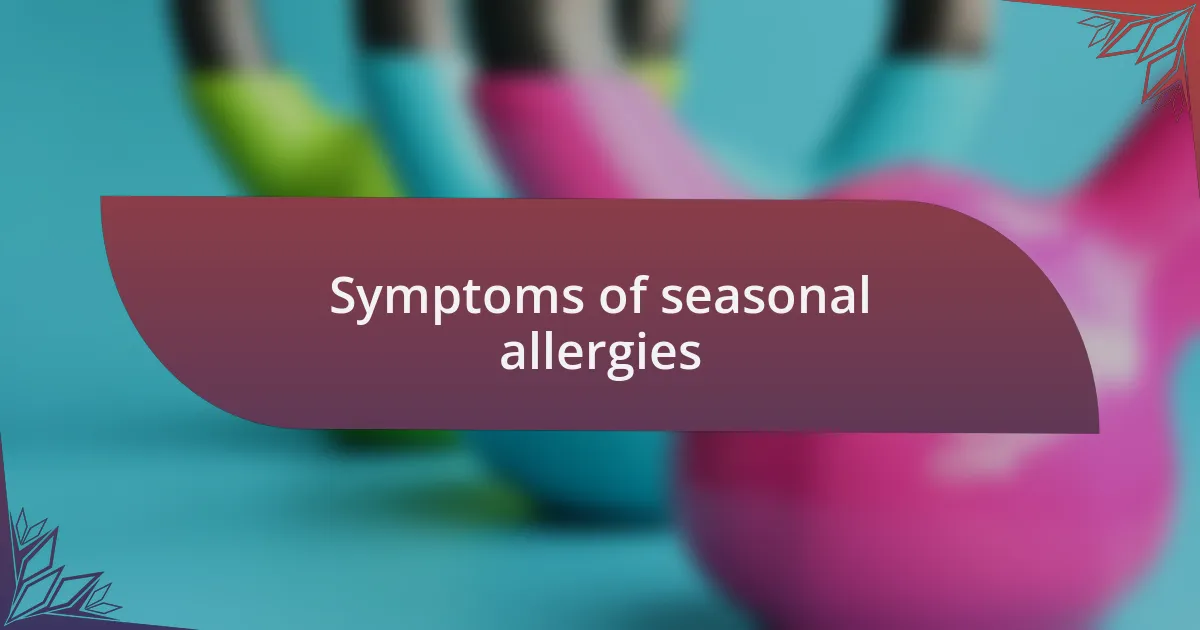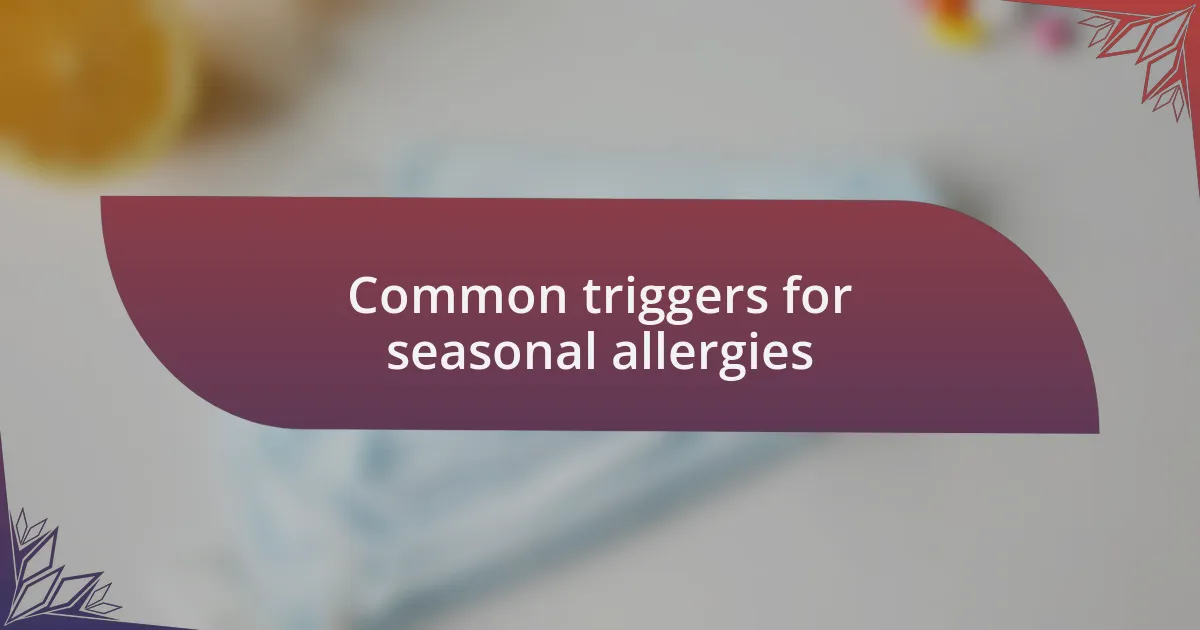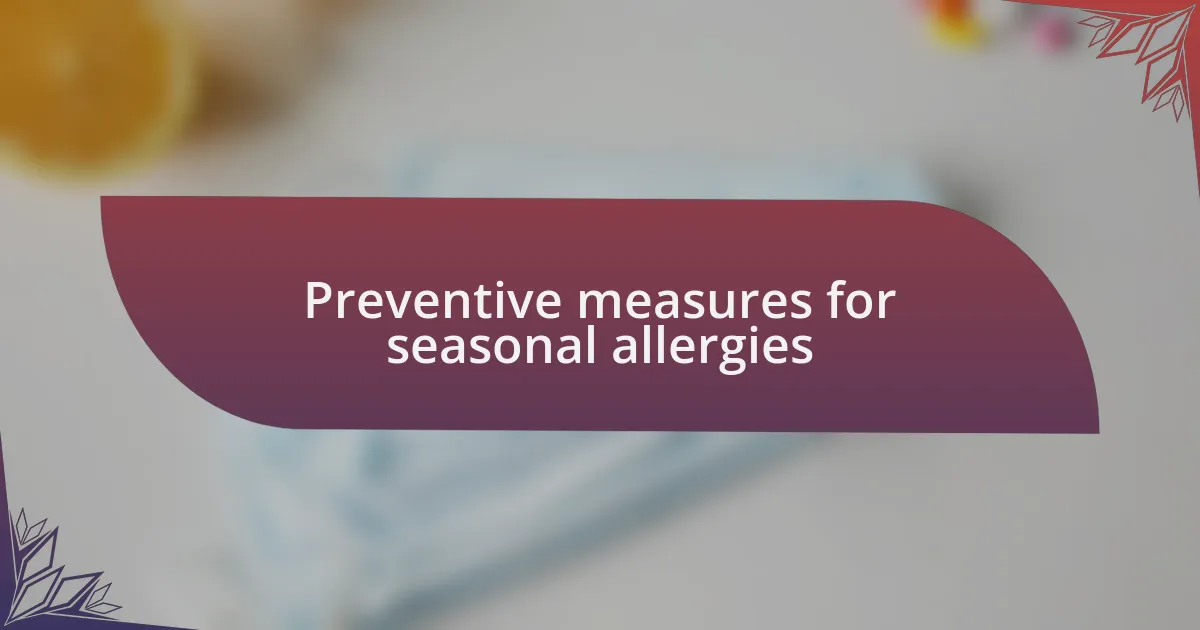Key takeaways:
- Seasonal allergies, or hay fever, are caused by the immune system’s overreaction to allergens such as pollen, mold, and dust mites, leading to symptoms like sneezing and congestion.
- Common triggers include pollen from flowers and weeds, as well as mold exacerbated by damp conditions.
- Preventive measures like keeping windows closed, staying indoors during high pollen counts, and using air purifiers can significantly reduce allergy symptoms.
- Effective symptom management includes having antihistamines on hand, using saline nasal rinses, and wearing sunglasses outdoors to protect against allergens.

Understanding seasonal allergies
Seasonal allergies, often referred to as hay fever or allergic rhinitis, occur when your immune system overreacts to allergens like pollen, mold spores, or dust mites. I still remember the first time I sneezed uncontrollably in spring; I had no idea that flowers could stir such chaos in my body. Have you ever felt that itch in your throat while stepping outside? It’s a frustrating reminder of how nature can both invigorate and afflict us.
During certain times of the year, typically spring and fall, the levels of these allergens can spike, leading to an array of symptoms like sneezing, congestion, and itchy eyes. I often find myself wondering how plants can be so beautiful yet so troublesome. The seasonality of these allergies makes them unique; they don’t affect everyone year-round, but when they do hit, it can feel overwhelming.
The science behind seasonal allergies lies in the body’s histamine response — our immune system mistakenly identifies harmless substances as threats and reacts accordingly. It’s fascinating and, at times, a bit maddening! Have you ever caught yourself questioning why your body seems to betray you during your favorite outdoor activities? Understanding this response is key to coping effectively, and I’ve learned that knowledge is the first step toward gaining control over my symptoms.

Symptoms of seasonal allergies
It’s interesting how the symptoms of seasonal allergies can sneak up on you. I remember one autumn, the leaves started to turn, and suddenly, I was hit with a barrage of sneezes that felt like a signal from nature itself. Sneezing, congestion, and that dreaded itch in my eyes can really put a damper on enjoying the great outdoors. Have you had that moment when you are outside, trying to breathe in the crisp air, only to be interrupted by a relentless tickle in your throat?
In addition to sneezing, my experience with seasonal allergies has often left me feeling fatigued and a bit foggy headed. It’s like a heavy blanket of pollen just settles on my mind, making it hard to focus. I’ve caught myself daydreaming of clear days when I can enjoy the sunshine, rather than reaching for tissues every few minutes. Have you ever wondered why something as seemingly benign as a flower could create such discomfort?
When the seasons change, my overactive immune system manifests as headaches and skin irritations, too. It’s perplexing how my body interprets nature’s beauty as a threat! I’ve found myself at the pharmacy, questioning the best over-the-counter remedies, all while dreaming of a sneeze-free day. How do you manage when the symptoms become overwhelming? Each sneeze feels like a reminder that allergy season is back, and I can’t help but wonder if there’s a way to reclaim those joyous moments outdoors.

Common triggers for seasonal allergies
Pollen is often the primary culprit behind seasonal allergies, particularly in spring and fall. I recall walking through a park in March, admiring the blossoms, only to find myself sneezing repeatedly. It was frustrating to realize that those beautiful flowers were the source of my misery. How could something so lovely make me feel so awful?
Another common trigger I’ve encountered is mold. After a rainy summer, I remember stepping into my yard and being immediately hit with that familiar feeling of congestion. The moist environment seemed to amplify the mold spores, and I could even feel my throat tightening. Have you ever noticed how damp conditions can significantly impact your allergies?
Then there are those pesky weeds. I had a friend once who was blissfully unaware of his allergies until we took a hike in late summer and suddenly, he was red-eyed and sniffling. This experience made me realize just how often we overlook common triggers like ragweed when we engage in outdoor activities. I sometimes wonder if we really pay enough attention to what might be lurking in our environment, ready to pounce on our immune systems. What strategies do you have in place to navigate these seasonal hazards?

Preventive measures for seasonal allergies
One of the most effective preventive measures I’ve found is keeping my windows closed, especially during peak pollen season. I remember a particularly warm spring when I decided to let the fresh air in and ended up paying for it with a week of relentless sneezing and itchy eyes. It’s incredible how much of a difference something as simple as closed windows can make. Have you ever considered how much outdoor allergens can invade your space without you even realizing it?
Staying indoors during high pollen counts is another strategy that has worked wonders for me. On days when the pollen forecast is particularly high, I find myself planning indoor activities, like reading or catching up on hobbies. I can still vividly recall the time I ignored the forecast and went for a run; it took days to recover from the aftermath. It makes me wonder—how often do we underestimate the impact of timing and environment on allergy symptoms?
Using air purifiers has been a game-changer in my battle against seasonal allergies. After investing in one, I distinctly felt a change in the air quality at home, as if I had created my own little sanctuary. I encourage you to think about the air you breathe indoors; it’s easy to forget that allergens can linger even when we think we’re safe. What steps have you taken to improve your indoor air quality?

Tips for managing symptoms effectively
When managing sneezy encounters with seasonal allergies, I’ve found that keeping medication on hand is crucial. There were times when I’d be caught off guard during an outdoor gathering, and having antihistamines available made a world of difference. Have you ever been in a situation where a quick remedy turned an uncomfortable moment into a manageable one?
Daily saline nasal rinses have become a part of my routine as well. I recall that once, after a particularly intense pollen surge, I felt like my sinuses were under siege. A simple rinse with a saline solution not only eased my discomfort but also provided a refreshing sensation, almost like hitting the reset button. It’s surprising how a few minutes dedicated to this practice can alleviate symptoms effectively.
I’ve also learned the importance of wearing sunglasses outdoors. On days when the pollen levels soar, I slip on my shades, and it’s like drawing a protective barrier against allergens. I still remember a summer picnic where I laughed at a friend wearing them, only to end up regretting not doing the same when my eyes became itchy and red. Isn’t it fascinating how a small adjustment like this can shift your entire outdoor experience?